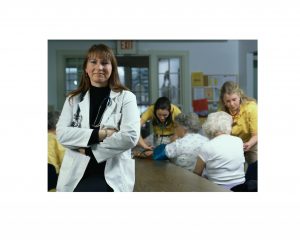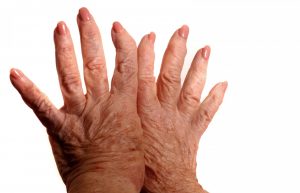Dr. Mauk’s Boomer Blog
Each week, Dr. Kristen Mauk shares thoughts relevant to Baby Boomers that are aimed to educate and amuse.
Dr. Kristen L. Mauk, PhD, DNP, RN, CRRN, GCNS-BC, GNP-BC, FAAN

7 Simple and Effective At-Home Workouts for Older Adults
Exercise and nutrition are important aspects of a healthy lifestyle and should be the focus of our everyday life. As we age, our body slows down, muscles become weak, and metabolism takes a hit. Simple activities like playing with grandkids, taking the stairs without getting winded or getting off the couch with little or no grunting can be challenging. Therefore, it’s important for the elderly to be physically active and make exercise a regular routine because it has some serious health benefits. For effective and easy home workout sessions buying a few home fitness equipment’s would be smart move.
Health Benefits of Exercise in Older Adults
Older adults have different reasons to stay in shape than the younger generation. Physical fitness is important for them to live a healthier, longer and more joyous life. The health benefits of exercise in seniors include:
- Independence
Exercise is one of the best ways to remain independent for older adults. Regular exercise keeps them active and helps with walking, cooking, eating, dressing, and using the restroom on their own.
- Improves balance
Regular exercise helps improve balance, so the older adults can do the activities they enjoy without straining or risking a fall.
- More energy
Exercise promotes the release of endorphins. These essential neurotransmitters are associated with pain mitigation and a sense of well-being. They help in combating stress hormones, promoting healthy sleep, and making them feel more lively and energetic.
- Prevents diseases
Old age makes them vulnerable to diseases such as osteoporosis, heart diseases, depression and diabetes. When they adopt a healthy and more active lifestyle, they can prevent these diseases or reduce the severity of the symptoms.
- Improves brain function and mental health
Seniors leading an active lifestyle is known to have improved cognitive health. A study from the Alzheimer’s Research & Prevention Foundation revealed that regular exercise reduces the risk of developing Alzheimer’s disease or dementia by nearly 50%.
At-Home Exercises for Older Adults
The best part of at-home exercises is that they are all about function; they are not very different from everyday movements, and yet you can get to make the most out of them. These exercises can be done with basic equipment like dumbells and resistance bands or with objects around the house. However, we recommend you to use a yoga mat for padding and also to reduce your chance of slipping. If you are not confident, ask someone to supervise you and provide support when needed.
- Walking
Walking is one of the most accessible and least stressful forms of exercise. Generally, 10,000 steps per day are recommended for a healthy lifestyle. But if you have difficulty walking or pain in the joints, settle down for a smaller number. Walking strengthens your muscles, lowers your risk of diabetes, heart disease, stroke, and colon cancer.
- Dumbbell strength training
Strength training is known to reduce the symptoms of osteoporosis, diabetes, back pain, and depression. It also helps you manage your weight, contributing to higher metabolism and better glucose management. Regular workout and strength training helps you in maintaining balance and stamina.
Some of the best dumbbell strength training exercises for improved balance and flexibility include:
- Tricep extension
- Bent-over row
- Overhead press
- Bicep curl
- Front raise
- Stretching Exercises
Stretching exercises help relieve some types of chronic pain. These exercises also increase flexibility. However, be mindful of your hip and knees while doing stretching exercises.
- Leg & Arm Raises
Leg and arm raises are simple yet effective ways to incorporate workouts for seniors at home. They not only improve strength but also help with balance. You can use a chair for support when doing leg raises. And if you want to increase the difficulty level of arm/leg raises, add a resistance band to your workouts.
- Resistance band workouts
Resistance bands are stretchy rubber strips used to add resistance to workouts. They are affordable, user-friendly, and hence are a great at-home workout for seniors. These resistance band exercises strengthen the core, improve mobility, posture, and balance.
Some resistance band workouts for seniors include:
- Triceps press
- Bicep curl
- Leg press
- Lateral raise
- Band pull apart
- Weight Training
Lightweight training helps prevent osteoporosis and increase muscle strength. Simple exercises such as wall push-ups can improve muscle mass, increase endurance and strength.
- Chair Yoga
This low-impact form of exercise is great for improving muscle strength, mobility, balance and flexibility. Chair yoga is less stressful on muscles, joints, and bones and hence a better option than conventional forms of yoga.
Chair yoga has been shown to improve mental health in seniors while improving sleep quality, lowering instances of depression, and helping seniors experience a general sense of well-being. Some popular chair yoga exercises for seniors include:
- Seated cow stretch
- Overhead stretch
- Seated cat stretch
- Seated twist
- Seated mountain pose
To lead a better quality of life, it’s important that you stay active. One way to do it is through regular exercise. Try the above at-home exercises for seniors and develop an exercise routine that works best for your health needs and capabilities.
Author Bio:
Sancket Kamdar, a certified weightlifting coach, and a successful entrepreneur founded
SF HealthTech with a single goal in mind – to bring high quality, international standard exercise equipment to help fitness enthusiasts and athletes reach the next level of fitness. When he’s not working on new equipment ideas and designs, he loves to create educational content about health, fitness, nutrition, and wellness. He also writes to help budding entrepreneurs on running and growing a business, based on his experience.
Alzheimer’s Disease
Alzheimer’s disease (AD) is the most common type of dementia seen in older adults. An estimated 5.4 million Americans of all ages had Alzheimer’s disease in 2012. Nearly half (45%) of people over the age of 85 have AD. By 2050, the number of individuals age 65 and over with Alzheimer’s could range from 11 million to 16 million unless science finds a way to prevent or effectively treat the disease. One in eight older adults has AD, and it is the sixth leading cause of death in the United States (Alzheimer’s Association, 2012). Those affected with AD may live from 3–20 years or more after diagnosis, making the life span with this disease highly variable.
Risk factors
Advanced age is the single most significant risk factor for AD (Alzheimer’s Association, 2012). More women than men have AD, but this is because women live longer than men, not because gender is a risk factor. Family history and heredity are also identified risk factors for AD, as are head trauma and poor cardiac health.
Warning Signs
Alzheimer’s disease is characterized by progressive memory loss. The person affected by AD is gradually less able to remember new information and memory lapses begin to affect daily function. It is a terminal disease that over its course will eventually leave a person completely dependent upon others for care.
Diagnosis
Initially, the clinical progression of the disease is slow with mild decline; however, deterioration increases the longer the person lives, with an average life span of 8 years after diagnosis (Cotter, 2002; Fletcher, Rapp, & Reichman, 2007). The underlying pathology is not clear, but a growth of plaques and fibrillary tangles, loss of synapses, and neuronal cell loss are key hallmarks of AD that interfere with normal cell growth and the ability of the brain to function. Absolutely definitive diagnosis is still through autopsy, although clinical guidelines make diagnosis easier than decades ago when less was known about the disease. Primary care physicians generally make the diagnosis through a thorough history, physical exam, cognitive testing, and labs. New criteria for diagnosis include staging the disorder and biomarkers (beta amyloid and tau in the cerebrospinal fluid and blood) (Alzheimer’s Association, 2012b). An MRI of the brain may be ordered to rule out other causes of symptoms.
The clinical course of AD is divided into several stages, depending on the source consulted. In the early course of AD, the person may demonstrate a loss of short-term memory. This involves more than common memory loss, such as where the keys were put, and may involve safety concerns such as forgetting where one is going while driving. The inability to perform math calculations and to think abstractly may also be evident. In the middle or moderate phase, many bodily systems begin to decline. The person may become confused as to date, time, and place. Communication skills become impaired and personality changes may occur. As cognitive decline worsens, the person may forget the names of loved ones, even their spouse. Wandering behavior as well as emotional changes, screaming, delusions, hallucinations, suspiciousness, and depression are common. The person with AD is less able to care for her- or himself and personal hygiene suffers. In the most severe and final phase, the person becomes completely dependent upon others, experiences a severe decline in physical and functional health, loses communication skills, and is unable to control voluntary functions. Death eventually results from body systems shutting down and may be accompanied by an infectious process. Although there is no single test, and the diagnosis may be one of exclusion, early diagnosis is important to maximize function and quality of life for as long as possible. Persons experiencing recurring and progressing memory problems or difficulties with daily activities should seek professional assistance from their physician.
Treatment
Treatment for AD is difficult. There are several medications (such as Aricept, Namenda, Razadyne, and Exelon) that may help symptoms (such as memory), but they do not slow the course of the disease. There is currently no cure; however, research continues to occur in pharmacology, nonpharmacology, and the use of stem cells to manage symptoms and perhaps one day eradicate the disease.
Treatment will focus on symptom management, particularly in the areas of behavior, safety, nutrition, and hygiene. Behavioral issues such as wandering and outbursts pose a constant challenge. Many long-term care facilities have special “memory care” units to care for Alzheimer’s patients from the early to late stages of the disease. These units provide great benefits such as consistent and educated caregivers with whom the patient or resident will be familiar, a safe and controlled environment, modified surroundings to accommodate wandering behaviors, and nursing care 24 hours a day. Additionally, nurses are present to manage medications and document outcomes of therapies. However, many family members wish to care for their loved ones at home for as long as possible.
Thus, another important aspect of care in AD is care for the caregivers. Howcroft (2004) suggested that “support from carers is a key factor in the community care of people with dementia, but the role of the caregiver can be detrimental to the physical, mental, and financial health of a carer” (p. 31). She goes on to say that the caregivers of persons with AD would benefit from training in how to cope with behaviors that arise in these patients and how to cope with practical and legal issues that may occur.
Research has shown that ongoing skills are needed by family caregivers to deal with the progressive decline caused by AD. In fact, “a 63% greater risk of mortality was found among unpaid caregivers who characterized themselves as being emotionally or mentally strained by their role versus noncaregivers” (National Conference of Gerontological Nursing Practitioners & National Gerontological Nursing Association, 2008b, p. 4). Adapting to stress, working on time management, maximizing resources, and managing changing behavior were all skills caregivers needed to develop in order to successfully manage home care of their loved ones. When interventions and resources were not used by caregivers in the early stages of the care recipient’s AD, the risk of a healthy patient being institutionalized due to caregiver burden was higher (Miller, Rosenheck & Schneider, 2012). Caregivers needed not only to acquire knowledge and skills, but also to make emotional adjustments themselves to the ever-changing situation.
Such findings suggest that nurses should focus a good deal of time on educating caregivers of persons with AD to cope with, as Nancy Reagan put it, “the long good-bye.” Scientists continue to explore the causes of AD and hope in the near future to be able to isolate the gene that causes it. In the meantime, results from a fascinating longitudinal study (called the Nun study) on aging and AD, which used a group of nuns who donated their brains to be examined and autopsied after death, has suggested that there is a connection between early “idea density” and the emergence of AD in later life. That is, essays the nuns wrote upon entry to the convent were analyzed and correlated with those who developed AD. It was found that those with lower idea density (verbal and linguistic skills) in early life had a significantly greater chance of developing AD (Grossi, Buscema, Snowdon, & Antuono, 2007; Snowdon, 2004). The nun study has allowed researchers to examine hundreds of brains so far in nuns who died between 75 and 107 years of age and discover other important facts such as a relationship between stroke and the development of AD in certain individuals, and the role of folic acid in protecting against development of AD (Snowdon, 2004). Scientists from a number of fields continue to research the causes and possible treatments for AD and the Nun study project is continuing at the University of Minnesota. Snowdon’s research suggests that early education, particularly in verbal and cognitive skills, may protect persons from AD in later life.
Adapted from Mauk, K. L., Hanson, P., & Hain, D. (2014). Review of the management of common illnesses, diseases, or health conditions. In K. L.
Mauk’s (Ed.) Gerontological Nursing: Competencies for Care. Sudbury, MA: Jones and Bartlett Publishers. Used with permission.
Caregiver Tips: Planning for Long-Term Cancer Care
Caregivers for long-term cancer care
Long-term cancer care supports cancer patients throughout their treatment journey. Patients diagnosed with cancer may choose a friend or family member as their cancer caregiver. When taking on the role of caregiver, make sure to understand how to best assist them. Here are some tips below to help get you started.
Tip 1: Understand the diagnosis of your cancer patient and how it affects them
Aggressive Cancers
Being a cancer caregiver opens up new responsibilities and challenges. There are many types of caregiving that provide help for the general health and wellbeing of patients. With cancer caregiving, patients often require specialized help. You may be familiar with senior or disability caregiving, but certain cancers are more difficult to manage. For example, breast cancer is common but involves a different caregiving approach than mesothelioma cancer. Mesothelioma is an aggressive cancer of the lungs that typically targets older adults.
There is currently no available cure for mesothelioma. This results in a 79 percent, 1-year survival rate, even with multimodal treatment—which combines one or two cancer treatments. Cancer patients and caregivers may have many questions surrounding treatment. For this reason, caregiver resources help plan and ease long-term mesothelioma cancer care. Take time to understand the type of cancer your patient has and how mesothelioma will affect them physically, mentally, and socially. The decision to have long-term cancer care is hard on the patient, too. Caregivers relieve some of the burdens patients will have. With this in mind, preparing for your patients will help you fully grasp this role.
It’s also crucial to work with the doctors and cancer teams to provide quality care. Depending on what type of caregiver you are, your responsibilities could change. More qualified caregivers may have to administer medications. Connecting with the doctor will help the cancer team with their prognosis strategy and your patient’s long-term cancer care. This will also help you better understand the patient’s needs.
Tip 2: Keep the patient, family and friends involved
It can be devastating when a loved one is diagnosed with cancer. Putting in the effort to work with your patient and their family will make them feel included and comfortable during this difficult time. Caregivers spend a lot of time with patients. By creating healthy relationships with them, you can give them the support and encouragement they need. Often, treatment is hard on patients and takes long recovery times. You will be one of their biggest advocates.
Tip 3: Pay attention to how you feel
Amidst the distress you and your patient will undergo, it’s vital to check in on yourself. It may seem as though your feelings aren’t as valid as those you are helping, but that isn’t the case. You won’t be able to fully care for your patient if you’re not caring for yourself as well. To avoid burnout, dedicate time for yourself to process your emotions and feelings, especially because of how draining long-term cancer caregiving can be.
If you are taking a cancer caregiver position, keep these tips in mind. Caregiving is not babysitting. Patients and their families rely on caregivers to handle what they cannot. Taking on this role is both an immense commitment and a privilege.
Guest Blog: Suffering From Arthritis: 5 Objects To Make Your Life Easier
Arthritis is one of the most common diseases of the bones and joints around the world, specifically in women. In the simplest of terms, it is the chipping away of the protective layer of bones that help them slide smoothly against each other as you move. When this layer is damaged, friction increases which damages the joints progressively
Long Rod Object Graspers
One inevitable outcome of arthritis is the inability to reach up to objects placed on high shelves. Even if you try and do it, you end up feeling a lot of pain and stiffness in the joints afterwards. As such, one object that can help you on a daily basis to manage arthritis and carry out your daily tasks is to get a long rod grasper that allows you to get hold of things without having to look up or move your neck significantly. Same goes for bending down to lower shelves. Use a grasper to bring the objects onto the front and pick them up with holders.
Wheel Walker/Cane
Most of the arthritis patients experience distress due to their movement being restricted because of the disease. Walkers or canes help shift your weight on them and aid you in moving about in a better way, around the house as well as outside. Arthritis intensifies more when you are heavy weight because then your bones and joints have to bear more pressure. As such, this object helps in dividing the weight and managing the disease a great deal.
Assistive Kitchen Equipment
When t comes to working in the kitchen which is unavoidable, use equipment that shares the work you do with hands. For example, use electric or levered can openers rather than using knives that require you to exert significant pressure.
Hot water bottle
This is a heavy rubber bottle in which you can pour hot water, seal it shut and use it to warm your joint stiffness, especially in the morning. Arthritis patients regularly experience morning joint stiffness due to a consistent inactivity during the sleep hours. This helps prepare you for movement throughout the day. Even during the day if constant work causes pain in the joints, you can sit for a couple of minutes to warm your joints with hot water bottle and feel better.
Skin Cancer in Older Adults
Background
There are three major types of skin cancer: basal cell, squamous cell, and malignant melanoma (MM). Basal cell carcinoma is the most common skin cancer, accounting for 65–85% of cases (Kennedy-Malone et al., 2000). According to the American Cancer Society (2013), more than 3.5 million cases of basal cell and squamous cell skin cancer are diagnosed every year. Squamous cell carcinoma is more common in African Americans and is also less serious than malignant melanoma. Malignant melanoma accounts for only 3% of all skin cancers, but it is responsible for the majority of deaths from skin cancer. Older adults are 10 times more likely to get MM than adults under age 40 (Johnson & Taylor, 2012). About 8,420 people were estimated to die from malignant melanoma in 2008. The American Cancer Society (2013) estimated that in 2013 there would be over 76,000 new cases of malignant melanoma in the United States.
Risk Factors
Older adults are more susceptible to skin cancers because of a variety of factors. These include exposure to carcinogens over time (such as through sunburn or tanning booths) and immunosenescence, or a decline in immune function. Family history of skin cancers, multiple moles (more than 100), and pale skin also put a person at higher risk. The major risk factor for all types of skin cancer is sun exposure.
Warning Signs
The ABCDE method can help people remember the warning signs of skin cancer:
A = Asymmetry (if a line is drawn down the middle of the lesion, the two sides do not match)
B = Border (the borders of the lesion tend to be irregular)
C = Color (a variety of colors is present; the lesion is not uniform in color)
D = Diameter (MM lesions are usually larger)
E = Evolving (note any changes in shape or size, or any bleeding)
Diagnosis
Annual physical examinations should include inspection of the skin for lesions. Older adults should be taught to report any suspicious areas on their skin to the physician. Persons should particularly look for changes in shape, color, and whether a lesion is raised or bleeds.
Basal Cell Carcinoma
Basal cell carcinoma (BCC) is the most common kind of skin cancer. It is often found on the head or face, or other areas exposed to the sun. Although there are different forms of BCC, the nodular type is most common, and appears as a raised, firm, papule that is pearly or shiny with a rolled edge. (Johnson & Taylor, 2012). Patients often complain that these lesions bleed and scab easily. When treated early, it is easily removed through surgery and is not life threatening, though it is often recurring.
Squamous Cell Carcinoma
Squamous cell carcinoma (SCC) also appears as lesion on areas of the body exposed to the sun, or from other trauma such as radiation. HPV is a risk factor of SCC, and metastasis is more common than with BCC. The lesions of SCC appear scaly, pink, and thicker than BCC. Their borders may be more irregular and the lesions may look more like an ulceration.
Malignant Melanoma
Malignant melanoma MM has a more distinctive appearance than other types of skin cancer. The areas appear asymmetric with irregular borders, a variety of colors (including black, purplish, and pink), and size greater than 6 mm. Malignant melanoma MM is often identified with the ABCDE method and MM accounts for the vast majority of deaths from skin cancer. The good news is that MM is almost always curable when found early. A skin check should be part of an older person’s yearly physical.
Treatment
The best treatment for skin cancer in the elderly is prevention. All older persons, especially those with fair skin who are prone to sunburn, should wear sunblock and protective clothing. Most skin cancers, when treated early, have a good prognosis.
All skin lesions larger than 6 mm, or those with any of the ABCDE signs, should be referred for biopsy. There are many nonsurgical interventions. These include cryotherapy, radiotherapy (for superficial BCC or SCC), electrodessication and curettage, and topical treatments. Topical treatments are generally not as effective as more aggressive interventions, but research is ongoing in this area.
The prognosis for MM depends on the extent and staging of the tumor, but when caught very early, the cure rate is nearly 100%. Malignant melanoma MM presenting in older adults is often more advanced and aggressive. Malignant melanoma MM metastases sites are typically the lymph nodes, liver, lung, and brain (Johnson & Taylor, 2012). Surgical treatment is required in malignant melanoma, with chemotherapy and radiation. Adjuvant treatments for MM are also often used.
http://www.cancer.org/cancer/skincancer-melanoma/detailedguide/
Guest Blog: Why Seniors Need To Hire An Elder Law Attorney
Given the rather complex legal concerns that the elderly have to face, seniors or those who are helping them make decisions should work hand-in-hand with an elder law attorney.
Seniors have rather unique legal needs, and elder law attorneys use their expertise in the different fields of law that elder law encompasses to serve those needs.
Let’s take a closer look at some of the reasons seniors need the services of a lawyer who specializes in elder law.
Help With Medicaid
Seniors are going to need long-term care, and Medicaid is at the forefront of providing them with the necessary funding for it. However, Medicaid’s rules and regulations for eligibility can get rather complex.
By applying legal strategies properly, an elder law attorney can help seniors navigate those complexities and get the Medicaid coverage they need and deserve, and protect their money, property, or income at the same time.
Estate Planning
The elderly will also require assistance with their estate planning.
Many seniors have yet to create wills, trusts, and powers of attorney. Others simply need to update and maintain their existing estate planning documents.
Elder law attorneys can help seniors with their estate planning to ensure that their assets are legally passed down without complication, and their wishes carried out to the letter.
Planning For Long-Term Care
It is a fact that health complications will eventually arise as people get older. For seniors, there is no better time to plan for long-term care than now, while they are still able to care for themselves.
Seniors will need to draft an advance health care directive, a document where they can specify the actions they want to be taken for their health in case they become incapacitated. They also need to plan for guardianship, so when they are no longer capable of caring for themselves, they can ensure that the court will appoint a guardian of their choosing. These are a couple of concerns that a skilled and experienced elder law attorney can help plan.
With an elder care attorney providing insight and expertise, seniors will be able to make sound legal decisions that will ensure that their future needs will be taken care of and help them get some much-needed peace of mind.
About the Author
Lauren Summers is the Content Marketing Strategist for Miller, Miller & Canby, one of the most respected law firms in Montgomery County, and the Washington, DC metropolitan area. The firm focuses on five core areas of practice: Land Development, Real Estate, Litigation, Business and Tax, and Trusts and Estates Law. In her spare time, she reads books and plays board games with her husband and two kids.







